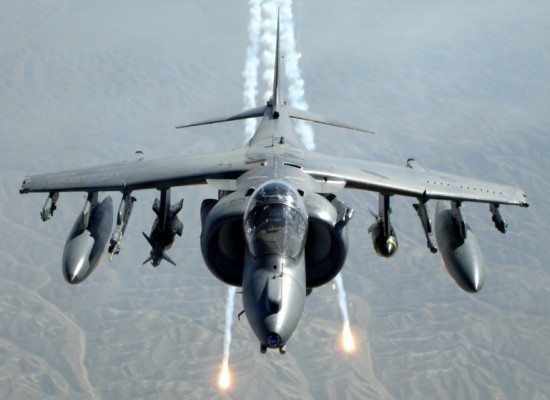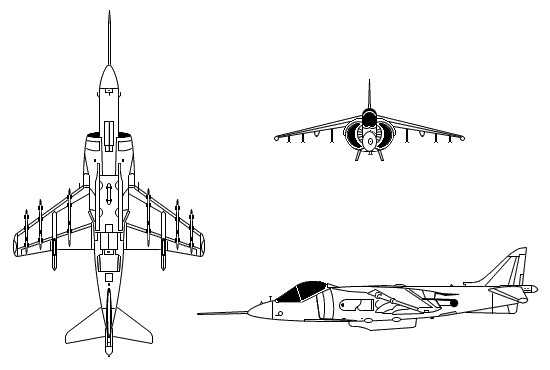|
||||||||||
|
|
||||||||||
|
||||||||||
|
|
||||||||||
 - -
 - -
|
|

|
McDonnell Douglas/ British Aerospace AV-8B Harrier II Attack Fighter |
|
DESCRIPTION:
It was originally believed that the development of an improved Harrier would be a joint 50/50 venture between Britain and the US. However, the British government decided in 1975 that there was insufficient common ground between the requirements of the US Marine Corps and the Royal Air Force for the project to proceed. Instead, McDonnell Douglas chose to develop the new Harrier on its own with British Aerospace as the principal subcontractor. The Marines were primarily interested in a close-support aircraft capable of operating from rough fields and amphibious assault ships. Later, Britain did decide to purchase a version of the Harrier II, the GR.5, with an emphasis on air combat and reconnaissance roles. The Harrier II is a much refined aircraft as compared to the original. Weight was reduced, engine lift increased, and the wing enlarged to produce greater lift while increasing fuel capacity and payload. The Harrier II fleets of both countries have seen action over Afghanistan where the aircraft provides rapid response to close air support requests. Following retirement of its Sea Harriers in 2006, the Royal Navy merged its air wings with the Royal Air Force to share the GR.7 and GR.9 under the designation Joint Force Harrier for both land and sea operations. The Harrier II has also been purchased by Italy and Spain for use aboard small aircraft carriers. Although variants of the AV-8B remain in service with the US Marine Corps, Spain, and Italy, the United Kingdom retired its aircraft in 2010 following a cost-cutting defense review. The remaining operators are expected to replace their Harrier II fleets with the STOVL version of the F-35 while the Royal Navy will likely purchase the conventional F-35C for its next-generation aircraft carriers.
Data below for AV-8B and GR.7 where indicated |
|
| HISTORY: | |
| First Flight |
(YAV-8B) 9 November 1978 (GR.5) 30 April 1985 (GR.7) 29 November 1989 |
| Service Entry |
(AV-8B) 12 January 1985 (GR.5) July 1987 (AV-8B II+) June 1993 |
| Retirement |
(GR.7) 31 March 2010 (GR.9) 15 December 2010 |
|
CREW:
|
one: pilot
|
|
ESTIMATED COST:
|
$23.7 million [2003$]
|
| AIRFOIL SECTIONS: | |
| Wing Root | unknown supercritical (11.5%) |
| Wing Tip |
unknown supercritical (7.5%)
|
| DIMENSIONS: | |
| Length |
(AV-8B) 46.33 ft (14.12 m) (GR.7) 47.07 ft (14.36 m) |
| Wingspan | 30.33 ft (9.25 m) |
| Height | 11.65 ft (3.55 m) |
| Wing Area | 230 ft² (21.37 m²) |
|
Canard Area
|
not applicable
|
| WEIGHTS: | |
| Empty |
(AV-8B) 13,970 lb (6,335 kg) (GR.7) 15,705 lb (7,125 kg) (AV-8B Plus) 14,865 lb (6,745 kg) |
| Normal Takeoff | 22,950 lb (10,410 kg) |
| Max Takeoff |
31,000 lb (14,060 kg) [short takeoff] (AV-8B) 20,595 lb (9,340 kg) [vertical takeoff] (GR.7) 19,180 lb (8,700 kg) [vertical takeoff] (AV-8B Plus) 20,755 lb (9,415 kg) [vertical takeoff] |
| Fuel Capacity |
internal: 7,800 lb (3,540 kg) external: 8,070 lb (3,661 kg) in four 300 gal (1,135 L) tanks |
|
Max Payload
|
(AV-8B) 13,235 lb (6,000 kg) [short takeoff] 4,000 lb (1,815 kg) [vertical takeoff] (GR.7) 10,800 lb (4,900 kg) |
| PROPULSION: | |
| Powerplant | one Rolls-Royce Pegasus Mk 105 vectored-thrust turbofan |
| Thrust |
21,750 lb (96.75 kN)
|
| PERFORMANCE: | |
| Max Level Speed |
at altitude: Mach 0.98 at sea level: 675 mph (1,085 km/h), Mach 0.89 |
| Initial Climb Rate | unknown |
| Service Ceiling | unknown |
| Range |
typical: 1,200 nm (1,110 km) ferry: (AV-8B) 1,800 nm (3,335 km) (GR.7) 1,600 nm (2,965 km) |
| Endurance | 3 hr |
| g-Limits |
+8 / -3
|
| ARMAMENT: | |
| Gun |
(AV-8B) two 25-mm General Electric GAU-12/U cannons (300 rds total) (GR.7) two 25-mm Aden gun pods (100 rds ea) |
| Stations |
(AV-8B) seven external hardpoints (GR.7) nine external hardpoints |
| Air-to-Air Missile | up to six AIM-9 Sidewinder, AIM-120 AMRAAM, Matra 550 Magic |
| Air-to-Surface Missile | AGM-12 Bullpup, AGM-62 Walleye, up to four AGM-65 Maverick, AGM-84 Harpoon, Sea Eagle, Wasp, Brimstone |
| Bomb | GBU-12/16/27 Paveway laser-guided, GBU-32/38 JDAM, Paveway IV, up to 15 Mk 82 GP, up to five Mk 83 GP, Mk 20 Rockeye, CBU-99 cluster, up to seven BL.755 |
| Other |
up to six Matra 155 rocket pods, ECM pods, 30-mm gun pods, recon camera pods
|
| KNOWN VARIANTS: | |
| AV-8A | Original US Harrier based on the British GR.1 (see Harrier & Sea Harrier) |
| YAV-8B | Prototype with a composite wing, redesigned engine intakes and exhaust nozzles, and improved lift devices rebuilt from AV-8A Harrier airframes to test features of a proposed AV-8B, successful demonstration resulted in a development contract in 1979; 2 converted |
| AV-8B Harrier II | Production day attack fighter for the US Marine Corps; 4 development versions and 162 production airframes built from 1982-1989 |
| TAV-8B Harrier II | Two-seat trainer for the USMC; 23 built from 1986-1992 |
| GR.5 | UK version of the Harrier II with different avionics, countermeasures, and weapon options than the US model; 41 built for the Royal Air Force |
| GR.5A | Slightly modified GR.5 model incorporating design changes in anticipation of the GR.7 standard; 21 built for the Royal Air Force |
| EAV-8B Matador II | Carrier-based attack model similar to the AV-8B built for the Spanish Navy; 12 built from 1987-1988 |
|
AV-8B Harrier II Night Attack |
Upgraded US Marine Corps model adding a Navigation Forward Looking Infrared (NAVFLIR) camera, upgraded cockpit, compatibility with night vision goggles, and an updated engine; many converted from original AV-8B airframes and 72 new airframes built from 1989-1993 |
| AV-8D | Early designation for the AV-8B Harrier II Night Attack variant |
| GR.7 | UK variant optimized for night attack and equipped with new cockpit displays and a HUD, TV/laser target trackers, and a FLIR, saw combat in Kosovo and Iraq and began deployments aboard aircraft carriers in 1997; 34 built and all GR.5 airframes upgraded to this standard |
| T.6 | Proposed two-seat trainer for the RAF based on the Harrier T.4 but incorporating GR.7 avionics; cancelled in 1990 in favor of a true Harrier II trainer called the T.10 |
|
T.10
|
RAF trainer based on the American TAV-8B except incorporating night attack and full combat capability; 13 built |
| GR.7A | Upgrade to GR.7 airframes adding a more powerful engine |
| AV-8B Harrier II+ | Similar to the AV-8B Harrier II Night Attack model except also incorporating an APG-65 radar; 72 converted and 43 built from 1993-1997 for use by the USMC and Italy |
| TAV-8B Harrier II+ | Two-seat trainer purchased by the Italian Navy; 2 built from 1990-1991 |
| EAV-8B Matador II+ | Spanish version of the Harrier II+; 11 converted from EAV-8B airframes and 8 new airframes built from 1995-1997 |
| GR.9 | GR.7 airframes upgraded with new inertial navigation and GPS systems plus the ability to carry smart weapons such as Maverick, Brimstone, and Enhanced Paveway laser-guided/GPS-guided bombs for improved ground attack in all-weather conditions |
| GR.9A | GR.7A airframes upgraded with the avionics and weapon options of the GR.9 |
|
T.12
|
T.10 trainers updated with the avionics and weapon upgrades of the GR.7 and GR.9 models
|
| KNOWN COMBAT RECORD: |
Iraq - Operation Desert Storm (USMC, 1991) Bosnia - Operation Deliberate Force (USMC, 1995) Kosovo - Operation Allied Force (USMC, RAF, 1999) Afghanistan - Operation Enduring Freedom (USMC, RAF, RN, 2001-present) Iraq - Operation Iraqi Freedom (USMC, RAF, 2003-present) Libya - Operation Odyssey Dawn (USMC, 2011) |
| KNOWN OPERATORS: |
Italy, Marina Militare (Italian Navy Aviation) Spain, Arma Aérea de la Armada Española (Spanish Naval Aviation) United Kingdom (Royal Air Force) United Kingdom (Royal Navy) United States (US Marine Corps) |
|
3-VIEW SCHEMATIC:

|
|
SOURCES:
|
|


|
Aircraft | Design | Ask Us | Shop | Search |

|
|
| About Us | Contact Us | Copyright © 1997- | |||
|
|
|||